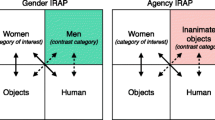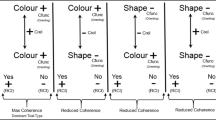Abstract
The current study examined the malleability of implicit attitudes using the Implicit Relational Assessment Procedure (IRAP). In Experiment 1, “similar” and “opposite” were presented as response options with the sample terms “old people” and “young people” and various positive and negative target stimuli. Results showed significantly faster response latencies for consistent (e.g., Similar- Positive-Young People) compared to inconsistent tasks (e.g., Similar-Positive-Old People). Explicit measures did not correlate with this IRAP effect. Experiment 2 determined whether prior exposure to pictures of admired and disliked old and young individuals had an impact on IRAP performance. Results revealed that pro-old exemplars reduced the pro-young IRAP effect, but reversed the anti-old effect, and this held for 24 h; explicit measures were largely unaffected. The findings suggest that the IRAP provides an informative measure of attitudechange following pro- versus anti-exemplar training.
Similar content being viewed by others
References
ALLPORT, G. W. (1954). The nature of prejudice. Reading, Ma: Addison-Wesley.
BANSE, R., SEISE, J., & ZERBES, N. (2001). Implicit attitudes towards homosexuality: Reliability, validity, and controllability of the tat. Zeitschrift fur Experimentelle Psychologie, 48, 145–160.
BARGH, J. A. (1999). The cognitive monster: The case against the controllability of automatic stereotype effects. In S. Chaiken & Y. Trope (Eds.), Dual-process theories in social psychology (pp. 361–382). New York: Guilford.
BARNES-HOLMES, D., BARNES-HOLMES, Y., POWER, P., HAYDEN, E., MILNE, R., & STEWART, I. (2006). Do you really know what you believe? Developing the Implicit Relational Assessment Procedure (Irap) as a direct measure of implicit beliefs. The Irish Psychologist, 32, 169–177.
BARNES-HOLMES, D., Barnes-Holmes, Y., Stewart, I., & Boles, S. (in press). A sketch of the Implicit Relational Assessment Procedure (Irap) and the Relational Elaboration and Coherence (Rec) model. The Psychological Record.
BARNES-HOLMES, D., HAYDEN, E., BARNES-HOLMES, Y, & STEWART, I. (2008). The Implicit Relational Assessment Procedure (Irap) as a response-time and event-related-potentials methodology for testing natural verbal relations: A preliminary study. The Psychological Record, 58, 497–516.
BARNES-HOLMES, D., HAYES, S. C, & DYMOND, S. (2001). Self and self-directed rules. In S. C. Hayes, D. Barnes-Holmes, & B. Roche (Eds.), Relational Trame Theory: A post-Skinnerian account of human language and cognition (pp. 119–140). New York: Plenum.
BARNES-HOLMES, D., MURTAGH, L., BARNES-HOLMES, Y, & STEWART, I. (IN PRESS). USING THE IMPLICIT ASSOCIATION TEST AND THE IMPLICIT RELATIONAL ASSESSMENT PROCEDURE TO MEASURE ATTITUDES TOWARDS MEAT AND VEGETABLES IN VEGETARIANS AND MEAT-EATERS. The Psychological Record.
BARNES-HOLMES, D., WALDRON, D., BARNES-HOLMES, Y, & STEWART, I. (2009). Testing the validity of the Implicit Relational Assessment Procedure (Irap) and the Implicit Association Test (Iat): Measuring attitudes towards Dublin and country life in Ireland. The Psychological Record, 59, 389–406.
BLAIR, I. V. (2002). The malleability of automatic stereotypes and prejudice. Personality and Social Psychology Review, 6, 242–261.
BLAIR, I. V., & BANAJI, M. R. (1996). Automatic and controlled processes in stereotype priming. Journal of Personality and Social Psychology, 70, 1142–1163.
BOSSON, J. K., SWANN, W B., & PENNEBAKER, J. W (2000). Stalking the perfect measure of implicit self-esteem: The blind men and the elephant revisited? Journal of Personality and Social Psychology, 79, 631–643.
BOYSEN, G. A., VOGEL, D. L., & MADON, S. (2006). A public versus private administration of the Implicit Association Test. European Journal of Social Psychology, 36, 845–856.
COHEN, J. (1988). Statistical power analysis for the behavioral sciences (2nd ed.). Hillsdale, NJ: Erlbaum.
DASGUPTA, N., & GREENWALD, A. G. (2001). On the malleability of automatic attitudes: Combating automatic prejudice with images of admired and disliked individuals. Journal of Personality and Social Psychology, 81, 800–814.
DE HOUWER, J. (2002). The Implicit Association Test as a tool for studying dysfunctional associations in psychopathology: Strengths and limitations. Journal of Behavior Therapy and Experimental Psychiatry, 33, 115–133.
DE HOUWER, J. (2003). The Extrinsic Affective Simon task. Experimental Psychology, 50, 77–85.
DE JONG, P. (2002). Implicit self-esteem and social anxiety: Differential self-positivity effects in high and low anxious individuals. Behaviour Research and Therapy, 40, 501–508.
DEVINE, P. G. (1989). Stereotypes and prejudice: Their automatic and controlled components. Journal of Personality and Social Psychology, 56, 5–18.
DEVINE, P. G., MONTEITH, M. J., ZUWERINK, J. R., & ELLIOT, A. J. (1991). Prejudice with and without compunction. Journal of Personality and Social Psychology, 60, 817–830.
FARNHAM, S. D., GREENWALD, A. G., & BANAJI, M. (1999). Implicit self-esteem. In D. Abrams & M. Hogg (Eds.), Social identity and social cognition (pp. 230–248). Oxford, Uk: Blackwell.
FAZIO, R.F.L, SANBONMATSU, D. M., POWELL, M. C., & KARDES, F. R. (1986). On the automatic activation of attitudes. Journal of Personality and Social Psychology, 50, 229–238.
GAWRONSKI, B., & BODENHAUSEN, G. V. (2007). Unraveling the processes underlying evaluation: Attitudes from the perspective of the Ape model. Social Cognition, 25, 687–717.
GREENWALD, A. G., & BANALI, M. R. (1995). Implicit social cognition: Attitudes, self-esteem, and stereotypes. Psychological Review, 102, 4–27.
GREENWALD, A. G., BANALI, M. R., RUDMAN, L. A., FARNHAM, S. D., NOSEK, B. A., & MELLOTT, D. S. (2002). A unified theory of implicit attitudes, stereotypes, self-esteem, and self-concept. Psychological Review, 109, 3–25.
GREENWALD, A. G., MCGHEE, D. E., & SCHWARTZ, J. L. K. (1998). Measuring individual differences in implicit cognition: The Implicit Association Test. Journal of Personality and Social Psychology, 74, 1464–1480.
GREENWALD, A. G., NOSEK, B. A., & BANALI, M. R. (2003). Understanding and using the Implicit Association Test: I. An improved scoring algorithm. Journal of Personality and Social Psychology, 85, 197–216.
GREENWALD, A. G., NOSEK, B. A., BANALI, M. R., & KLAUER, K. C. (2005). Validity of the salience asymmetry interpretation of the Implicit Association Test: Comment on Rothermund and Wentura (2004). Journal of Experimental Psychology: General, 134, 420–425.
HAYES, S. C., BARNES-HOLMES, D., & ROCHE, B. (2001). Relational Frame Theory: A post-Skinnerian account of human language and cognition. New York: Plenum.
ELENEC, P., & STEFFENS, M. C. (2002). Implicit attitudes towards elderly women and men. Current Research in Social Psychology, 7, 275–293.
KAWAKAMI, K., DOVIDIO, J. F., MOLL, J., HERMSEN, S., & RUSSIN, A. (2000). Just say no (to stereotyping): Effect of training in the negation of stereotypic associations on stereotype activation. Journal of Personality and Social Psychology, 78, 871–888.
LEPORE, L., & BROWN, R. (1997). Category and stereotype activation: Is prejudice inevitable? Journal of Personality and Social Psychology, 72, 275–287.
LOWERY, B., HARDIN, C. D., & SINCLAIR, S. (2001). Social tuning effects on automatic racial prejudice. Journal of Personality and Social Psychology, 81, 842–855.
MCKENNA, I. M., BARNES-HOLMES, D., BARNES-HOLMES, Y, & STEWART, I. (2007). Testing the fake-ability of the Implicit Relational Assessment Procedure (Irap): The first study. International Journal of Psychology and Psychological Therapy, 7, 123–138.
MOSKOWITZ, G. B., SALOMON, A. R., & TAYLOR, C. M. (2000). Preconsciously controlling stereotyping: Implicitly activated egalitarian goals prevent the activation of stereotypes. Social Cognition, 18, 151–177.
MYRDAL, G. (1944). An American dilemma: The Negro problem and modern democracy. New York: Harper.
NOSEK, B., & BANAJI, M. R. (2001). The go/no-go association task. Social Cognition, 19, 625–666.
NOSEK, B. A., BANAJI, M., & GREENWALD, A. G. (2002). Harvesting implicit group attitudes and beliefs from a demonstration web site. Group Dynamics, 6, 101–115.
NOSEK, B., GREENWALD, A. G., & BANAJI, M. R. (2004). Understanding and using the Implicit Association Test: Ii. Method variables and construct validity. Personality and Social Psychology Bulletin, 31, 166–180.
POWER, P. M., BARNES-HOLMES, D., BARNES-HOLMES, Y., & STEWART, I. (in press). The Implicit Relational Assessment Procedure (Irap) as a measure of implicit relative preferences: A first study. The Psychological Record.
PRATTO, F., & JOHN, O. P. (1991). Automatic vigilance: The attention grabbing power of negative social information. Journal of Personality and Social Psychology, 61, 380–391.
ROTHERMUND, K., & WENTURA, D. (2001). Figure-ground asymmetries in the Implicit Association Test (Iat). Zeitschrift fuer Experimentelle Psychologie, 48, 94–106.
RUDMAN, L. A., & CLICK, P. (2001). Prescriptive gender stereotypes and backlash toward agentic women. Journal of Social Issues, 57, 743–762.
RUDMAN, L. A., GREENWALD, A. G., MELLOTT, D. S., & SCHWARTZ, J. L. K. (1999). Measuring the automatic components of prejudice: Flexibility and generality of the Implicit Association Test. Social Cognition, 17, 437–465.
VAHEY, N. A., BARNES-HOLMES, D., BARNES-HOLMES, Y., & STEWART, I. (2009). A first test of the Implicit Relational Assessment Procedure (Irap) as a measure of self-esteem: Irish prisoner groups and university students. The Psychological Record, 59, 371–388.
Author information
Authors and Affiliations
Corresponding author
Additional information
Preparation of the current article was supported by postgraduate scholarships awarded to Claire Cullen from the Irish Research Council for Science, Engineering and Technology, and from NUI, Maynooth (John and Pat Hume Postgraduate Scholarships Scheme).
Rights and permissions
About this article
Cite this article
Cullen, C., Barnes-Holmes, D., Barnes-Holmes, Y. et al. The Implicit Relational Assessment Procedure (IRAP ) and the Malleability of Ageist Attitudes. Psychol Rec 59, 591–620 (2009). https://doi.org/10.1007/BF03395683
Published:
Issue Date:
DOI: https://doi.org/10.1007/BF03395683




